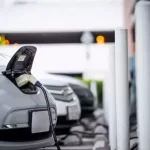The Future of Mobility-as-a-Service

With MaaS, users can communicate their travel needs to a digital service platform (DSP) that – for a fee – makes a multi-modal journey match. Services range from individual ‘little vehicle’ owners offering lift sharing, to car clubs and bike-sharing systems.
Leaders can then optimize transport options to meet rider demands. This can reduce traffic congestion, and the need for space for parking.
The Future of Mobility-as-a-Service
Today, residents can use a myriad of travel options to get around their cities — bus, streetcar, train, car-share, free float bike services and electric scooters. They can also access a variety of transportation and mobility solutions through mobile apps. However, these services are often siloed, making it difficult to choose the best options or plan a seamless journey.
Enter the concept of mobility-as-a-service (MaaS). Dubbed the “Netflix of transportation” or the “Uber of mobility,” MaaS is a unified platform that efficiently services your door-to-door travel needs with one simple-to-use app, combining on-demand transit services like Uber-style ride-sharing and pop-up bus routes with micro mobility modes like e-scooters.
This new model has the potential to reduce dependency on private cars and increase efficiency for people, transportation systems and cities. It can reduce traffic congestion, cut transportation costs, and promote more environmentally-friendly modes of transport. But it will also require careful analysis and planning. This is where actuaries can play a key role.
Integration of Public Transportation and Other Mobility Services
Currently, many journey planning, ticketing and payment services are available for individual transport modes and are either standalone apps or incorporated into other software products (e.g. TransitApp, Whim). It is also common for private companies to own and operate these services as well (e.g. My Cicero, Moovel).
The growing demand for more tailored mobility solutions has been a driving force behind the development of MaaS. People are looking to avoid the hassle of owning a car that sits idle in their garage and instead access on-demand ridesharing services, public transportation options or even bicycle and scooter sharing systems.
The MaaS concept aims to put all these different transport modes together into one user-focused digital service. This allows people to book their entire journey with one app, which may include fare products from several transport providers bundled into a single mobility package. This has the potential to increase uptake of new modes as users are less likely to be confronted with a new set of administrative processes and requirements.
Integration of Vehicles
Modern technology is revolutionising the way we travel around cities. The rideshare services Uber and Lyft, mapping apps, bicycle-sharing systems and the imminent arrival of autonomous vehicles all offer a range of options for getting from A to B.
But they aren’t always well integrated, and it can be difficult for individuals to navigate them all. This is where MaaS comes in.
Mobility-as-a-Service provides a one-stop shop that allows users to plan, book and pay for their trips (regardless of the means of transport they choose) through a single platform. It simplifies the wide variety of urban transportation options available to consumers, reduces friction between different mobility services and helps cities and transit agencies to improve service coordination and overall efficiency. It also offers power to individuals to shape the evolution of mobility systems. This is a revolutionary concept with far-reaching implications. Ultimately, it could greatly reduce dependence on private vehicles, cut traffic congestion and increase the use of environmentally-friendly transportation options.
Integration of Data and Analytics
Over the last ten years, new models have emerged to provide on-demand transportation alternatives to private vehicle ownership. These include ride-sharing, car-sharing, bike-sharing, scooter-sharing, and on-demand public transit services.
These services are increasingly seen as more convenient and sustainable than owning and operating a private vehicle [2]. They can also reduce congestion in city centers and suburbs, increase road safety, and decrease the amount of space needed for parking.
These innovations are fueled by booming demand for more personalized transport options. However, the COVID-19 pandemic and global travel restrictions have impacted the viability of many new mobility services. It is also important to understand that new mobility services are not intended to replace traditional modes of transportation, but rather to supplement them.






